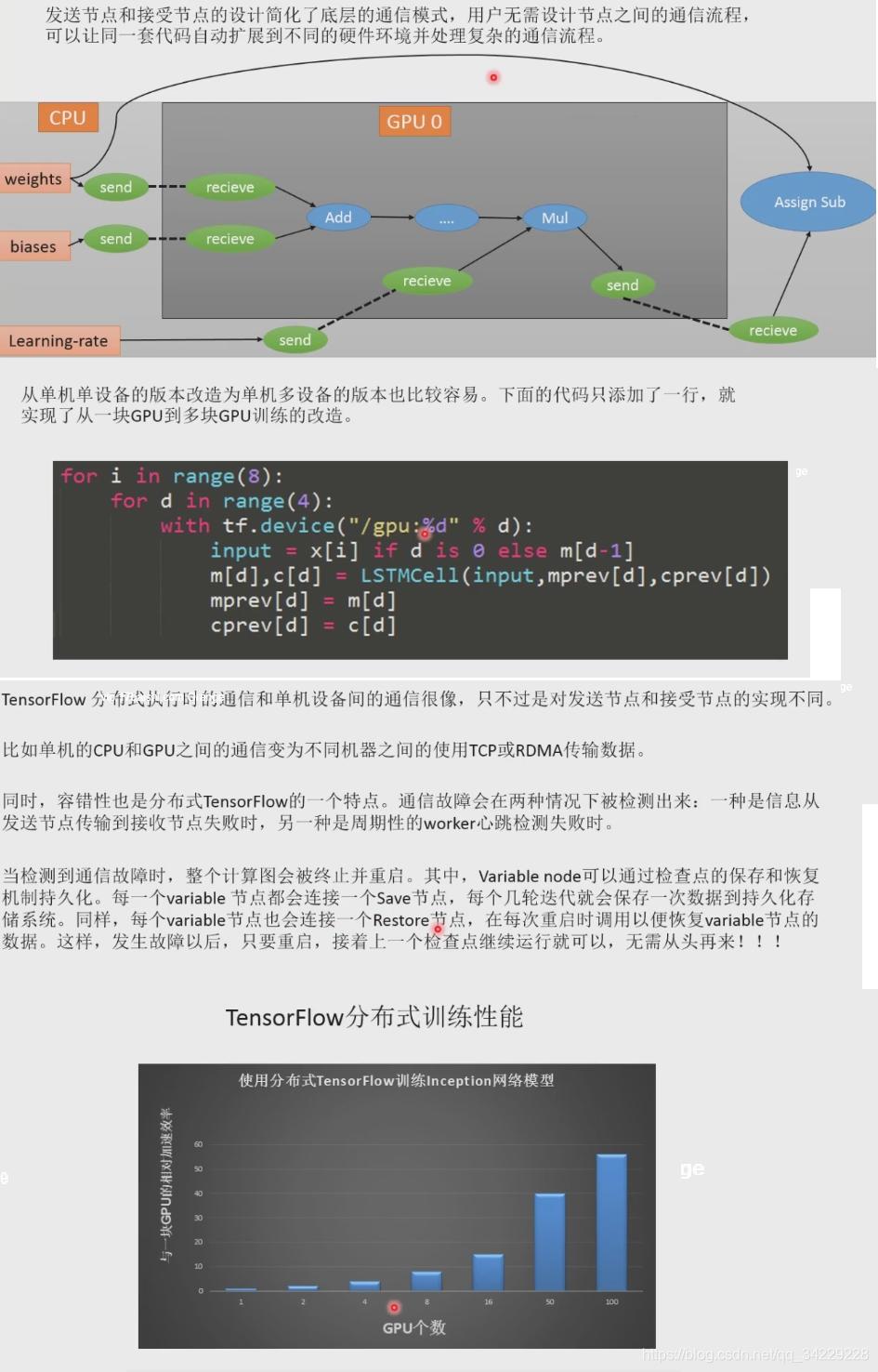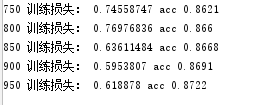目录
一、Tensorflow优点和基础架构
1、优点

2、基础架构

二、Tensorflow核心概念
计算图、运算操作、变量、会话
1、计算图
1) 什么是计算图?

2) 计算图的构造流程

2、操作节点


3、变量
1) 变量的创建

2)变量的初始化

3)变量的保存和恢复

4、会话

三、Tensorflow 实现原理



四、Tensorflow扩展功能
1、自动求导

2、字图执行

3、计算图控制流

4、队列\容器

五、Tensorflow性能优化
1、运算操作节点重组和调度

2、异步计算支持(并行)

3、第三方计算库

4、三种并行计算模式
- 数据并行模式

- 模型并行模式

- 流水线并行模式

- 三种并行方式比较

六、深度学习框架

七、常用常量/变量/矩阵操作
import tensorflow as tf
"""打印hello world"""
a = tf.constant("hello world")
with tf.Session() as sees:
print(sees.run(a))
# 基本常量操作
# 构造函数返回值就是常量节点的输出
a1 = tf.constant(2)
a2 = tf.constant(3)
# 启动默认计算图
with tf.Session() as sees:
print('常量相加:', sees.run(a1 + a2))
print('常量相乘:', sees.run(a1 * a2))
# 使用变量作为计算图输入
# 定义输入, tf.placeholder为占位符
a2 = tf.placeholder(tf.int16)
b2 = tf.placeholder(tf.int16)
# 定义操作
add = tf.add(a2, b2)
mul = tf.multiply(a2, b2)
# 启动会话
with tf.Session() as sees:
print('变量相加:', sees.run(add, feed_dict={a2: 2, b2: 3}))
print('变量相乘:', sees.run(mul, feed_dict={a2: 2, b2: 3}))
# 使用矩阵作为计算图输入
matrix1 = tf.constant([[2, 2]])
matrix2 = tf.constant([[1], [2]])
# 定义矩阵相乘操作
mul_mat = tf.matmul(matrix1, matrix2)
with tf.Session() as sees:
print('矩阵相乘:', sees.run(mul_mat))
1、tf.placeholder()

八、Tensorflow构建KNN分类器
原理

Tensorflow实现KNN需要以下几步:


import numpy as np
import tensorflow as tf
# 这里使用TensorFlow自带的数据集作为测试,以下是导入数据集代码
from tensorflow.examples.tutorials.mnist import input_data
mnist = input_data.read_data_sets("/tmp/data/", one_hot=True)
Xtrain, Ytrain = mnist.train.next_batch(5000) # 从数据集中选取5000个样本作为训练集
Xtest, Ytest = mnist.test.next_batch(200) # 从数据集中选取200个样本作为测试集
# 输入占位符
xtr = tf.placeholder('float', [None, 784])
xte = tf.placeholder('float', [1, 784])
# 计算L1距离
distance = tf.reduce_sum(tf.abs(tf.add(xtr, tf.negative(xte))), axis=1)
# 获取最小距离的索引
pred_index = tf.arg_min(distance, 0)
# 分类精确度
acc = 0.
# 初始化变量
init = tf.global_variables_initializer()
# 启动会话
with tf.Session() as sees:
sees.run(init)
for i in range(Xtest.shape[0]):
index = sees.run(pred_index, feed_dict={xtr: Xtrain, xte: Xtest[i, :].reshape(1, 784)})
true = np.argmax(Ytest[i]) # 第i个样本的真实标签
pred_x = np.argmax(Ytrain[index]) # 第i个样本的预测标签
print('预测值', pred_x, '真实值', true)
if pred_x == true:
acc += 1
acc = acc / Xtest.shape[0]
print('精确度', acc)
# 保存事件日志到tensorboard
writer = tf.summary.FileWriter("./logs", tf.get_default_graph())
writer.close()

九、Tensorboard可视化
1、WEB可视化
- E: 进入E盘
- cd E:\tensorflow_study\MNIST\logs 进入事件日志的上一级目录
- tensorboard.exe --logdir=E:\tensorflow_study\MNIST\logs

- 打开浏览器,输入localhost:6006

2、summary语句






十、Tensorflow实现一元线性回归
import numpy as np
import pandas as pd
import tensorflow as tf
import matplotlib.pyplot as plt
"""读入数据"""
data=pd.read_csv(r'E:\tensorflow_study\MNIST\my_data\Advertising.csv')
#归一化数据
x=data['TV'],y=data['Sales']
x_mean=np.mean(x)
y_mean=np.mean(y)
x_std=np.std(x)
y_std=np.std(y)
x=(x-x_mean)/x_std
y=(y-y_mean)/y_std
x_train=x[1:150]
y_train=y[1:150]
x_test=x[150:200]
y_test=y[150:200]
# x_train = np.linspace(0,10,100) + np.random.uniform(-1.5,1.5,100)
# y_train = np.linspace(0,10,100) + np.random.uniform(-1.5,1.5,100)
# x_test = np.linspace(0,10,20) + np.random.uniform(-1.5,1.5,20)
# y_test = np.linspace(0,10,20) + np.random.uniform(-1.5,1.5,20)
"""数据可视化"""
plt.plot(x_train,y_train,'ro')
plt.plot(x_test,y_test,'b*')
"""构建计算图"""
with tf.Graph(). as_default():
#1
# 输入占位符
with tf.name_scope('Input'):
x=tf.placeholder('float',name='X')
y=tf.placeholder('float',name='Y')
# 2、前向计算和损失
with tf.name_scope('Inference'):
w=tf.Variable(tf.zeros([1]),name='weight')
b = tf.Variable(tf.zeros([1]),name='bias')
y_hat=tf.add(tf.multiply(w,x),b)
with tf.name_scope('Loss'):
loss_train= tf.reduce_mean(tf.pow(y_hat-y,2))/2
#3训练,# 创建梯度下降优化器
with tf.name_scope('Train'):
optimizer=tf.train.GradientDescentOptimizer(learning_rate=0.01)
#定义train节点,将优化器应用到loss_train
trainOP=optimizer.minimize(loss_train)
# 4、评估
with tf.name_scope('Evaluate'):
Evalloss=tf.reduce_mean(tf.pow(y_hat-y,2))/2
# 添加初始化节点
initOP=tf.global_variables_initializer()
with tf.Session() as sees:
sees.run(initOP)
for i in range(1000):
_,train_loss,train_w,train_b=sees.run([trainOP,loss_train,w,b],feed_dict={x:x_train,y:y_train})
if i%5==0:
print(i,"步:",'Loss:',train_loss,'W:',train_w,'b:',train_b)
#y_pred,test_loss=sees.run([y_hat,Evalloss],feed_dict={x:x_test,y:y_test})
#print('真实值:',y_test,'预测值:',y_pred)
Y=sees.run(y_hat,feed_dict={x:np.linspace(np.min(x_train),np.max(x_train),100)})
plt.plot(np.linspace(np.min(x_train),np.max(x_train),100),Y,'-')
plt.show()
print('训练完毕')


需要注意的是,一开始没有进行数据归一化,结果发生了梯度爆炸的情况,损失和参数均为nan
十一、Softmax回归分类器
任务:MNIST手写数字识别
数据下载:
from tensorflow.examples.tutorials.mnist import input_data
mnist = input_data.read_data_sets(r"E:\tensorflow_study\MNIST\MNIST_DATA", one_hot=True)
print("保存完毕")
数据结构:

分类模型:


注意:tensorflow不同维数矩阵可以相加
with tf.Session() as sees:print(sees.run(tf.zeros([2, 10]) + tf.ones([10])))
[[1. 1. 1. 1. 1. 1. 1. 1. 1. 1.]
[1. 1. 1. 1. 1. 1. 1. 1. 1. 1.]]
import numpy as np
import pandas as pd
import matplotlib.pyplot as plt
import tensorflow as tf
from tensorflow.examples.tutorials.mnist import input_data
print('开始读入数据')
mnist = input_data.read_data_sets(r"E:\tensorflow_study\MNIST\MNIST_DATA", one_hot=True)
print('数据读取完毕')
"""读入数据"""
"""构建计算图"""
with tf.Graph().as_default():
with tf.name_scope('Input'):
X = tf.placeholder(tf.float32, shape=[None, 784], name='X')
Y = tf.placeholder(tf.float32, shape=[None, 10], name='Y')
# 前向预测,
with tf.name_scope('Inference'):
W = tf.Variable(tf.zeros([784, 10]), name='weight')
b = tf.Variable(tf.zeros([10]), name='bias')
logits = tf.add(tf.matmul(X, W), b)
# Softmax将不规则输出logits变为服从概率分布的输出
with tf.name_scope('Softmax'):
Y_pre = tf.nn.softmax(logits=logits)
# 定义交叉熵损失
with tf.name_scope('Loss'):
loss = tf.reduce_mean(-tf.reduce_sum(Y * tf.log(Y_pre), axis=1))
# Train 定义训练节点
with tf.name_scope('Train'):
optimizer = tf.train.GradientDescentOptimizer(learning_rate=0.01)
# 定义train节点,将优化器应用到loss_train
trainOP = optimizer.minimize(loss)
# Evaluate评估节点
acc=0.
with tf.name_scope('Evaluate'):
# 把one-hot编码解开,返回预测标签
y_true=tf.argmax(Y,axis=1)
y_hat=tf.argmax(Y_pre,axis=1)
#tf.cast()函数的作用是执行 tensorflow 中张量数据类型转换
# tf.equal逐个元素判等,返回布尔型
acc=tf.reduce_mean(tf.cast(tf.equal(y_true,y_hat),dtype=tf.float32))
InitOP = tf.global_variables_initializer()
# 计算图可视化,写入tensorboard
writer = tf.summary.FileWriter("./logs", tf.get_default_graph())
writer.close()
"""运行计算图"""
with tf.Session() as sees:
sees.run(InitOP)
# 开始按批次训练,共训练1000批次,每批次100个数据
for i in range(1000):
batch_xs, batch_ys = mnist.train.next_batch(100)
_, trainloss = sees.run([trainOP, loss], feed_dict={X: batch_xs, Y: batch_ys})
if i%50==0:
test_acc = sees.run(acc, feed_dict={Y: mnist.test.labels, X: mnist.test.images})
# 训练集准确率
print(i,"训练损失:",trainloss,'acc',test_acc)

十一、神经网络构建

"""mnist.py""""
import math
import tensorflow as tf
# The MNIST dataset has 10 classes, representing the digits 0 through 9.
NUM_CLASSES = 10
# The MNIST images are always 28x28 pixels.
IMAGE_SIZE = 28
IMAGE_PIXELS = IMAGE_SIZE * IMAGE_SIZE
batch_size = 50 # 每个批次的样本数量
hidden1_units = 20 # 第一个隐藏层神经元个数
hidden2_units = 15 # 第二个隐藏层神经元个数
learning_rate=0.1 #优化器的学习率
# 输入张量
images_placeholder = tf.compat.v1.placeholder(tf.float32, shape=(batch_size, IMAGE_PIXELS))
labels_placeholder = tf.compat.v1.placeholder(tf.int32, shape=(batch_size))
# 前向计算
def inference(images, hidden1_units, hidden2_units):
"""Build the MNIST model up to where it may be used for inference.
Args:
images: Images placeholder, from inputs().
hidden1_units: Size of the first hidden layer.
hidden2_units: Size of the second hidden layer.
Returns:
softmax_linear: Output tensor with the computed logits.
"""
# Hidden 1
with tf.compat.v1.name_scope('hidden1'):
weights = tf.Variable(tf.random.truncated_normal([IMAGE_PIXELS, hidden1_units],
stddev=1.0 / math.sqrt(float(IMAGE_PIXELS))), name='weights')
biases = tf.Variable(tf.zeros([hidden1_units]),name='biases')
hidden1 = tf.nn.relu(tf.matmul(images, weights) + biases)
# Hidden 2
with tf.compat.v1.name_scope('hidden2'):
weights = tf.Variable(tf.random.truncated_normal( [hidden1_units, hidden2_units],
stddev=1.0 / math.sqrt(float(hidden1_units))), name='weights')
biases = tf.Variable(tf.zeros([hidden2_units]),name='biases')
hidden2 = tf.nn.relu(tf.matmul(hidden1, weights) + biases)
# Linear
with tf.compat.v1.name_scope('softmax_linear'):
weights = tf.Variable(tf.random.truncated_normal([hidden2_units, NUM_CLASSES],
stddev=1.0 / math.sqrt(float(hidden2_units))), name='weights')
biases = tf.Variable(tf.zeros([NUM_CLASSES]),name='biases')
logits = tf.matmul(hidden2, weights) + biases
return logits
# 定义损失函数
def loss(logits, labels):
"""Calculates the loss from the logits and the labels.
Args:
logits: Logits tensor, float - [batch_size, NUM_CLASSES].
labels: Labels tensor, int32 - [batch_size].
Returns:
loss: Loss tensor of type float.
"""
labels = tf.cast(labels, dtype=tf.int64)#将labels转为int64
return tf.compat.v1.losses.sparse_softmax_cross_entropy(labels=labels, logits=logits)#交叉熵损失
#定义train字图
def training(loss, learning_rate):
optimizer = tf.compat.v1.train.GradientDescentOptimizer(learning_rate)
train_op = optimizer.minimize(loss)
return train_op
# 评估
def evaluation(logits, labels):
"""Evaluate the quality of the logits at predicting the label.
Args:
logits: Logits tensor, float - [batch_size, NUM_CLASSES].
labels: Labels tensor, int32 - [batch_size], with values in the
range [0, NUM_CLASSES).
Returns:
A scalar int32 tensor with the number of examples (out of batch_size)
that were predicted correctly.
"""
# For a classifier model, we can use the in_top_k Op.
# It returns a bool tensor with shape [batch_size] that is true for
# the examples where the label is in the top k (here k=1)
# of all logits for that example.
correct = tf.nn.in_top_k(predictions=logits, targets=labels, k=1) #布尔
# Return the number of true entries.
return tf.reduce_sum(input_tensor=tf.cast(correct, tf.int32))
#nn_logits=inference(images_placeholder, hidden1_units, hidden2_units)
#nn_loss=loss(logits=nn_logits,labels=labels_placeholder)
#train_on_batch=training(loss=nn_loss, learning_rate=learning_rate)
#correct_count=evaluation(logits=nn_logits,labels=labels_placeholder)
# 计算图可视化,写入tensorboard
#writer = tf.summary.FileWriter("./logs", tf.get_default_graph())
#writer.close()

运行计算图

"""full_connecttd_feed.py"""
import time
import numpy as np
import tensorflow as tf
from MY_MNIST import nn_mnist
from tensorflow.examples.tutorials.mnist import input_data
print('开始读入数据')
mnist = input_data.read_data_sets(r"E:\tensorflow_study\MNIST\MNIST_DATA", one_hot=True)
print('数据读取完毕')
"""导入数据"""
# The MNIST dataset has 10 classes, representing the digits 0 through 9.
NUM_CLASSES = 10
IMAGE_SIZE = 28
IMAGE_PIXELS = IMAGE_SIZE * IMAGE_SIZE
batch_size = 100 # 每个批次的样本数量
hidden1_units = 20 # 第一个隐藏层神经元个数
hidden2_units = 15 # 第二个隐藏层神经元个数
learning_rate=0.1 #优化器的学习率
"""构建并可视化计算图"""
"""初始化节点,运行计算图"""
def creat_graph():
images_placeholder=nn_mnist.images_placeholder
labels_placeholder=nn_mnist.labels_placeholder
nn_logits=nn_mnist.inference(images_placeholder, hidden1_units, hidden2_units)
nn_loss=nn_mnist.loss(logits=nn_logits,labels=labels_placeholder)
train_on_batch=nn_mnist.training(loss=nn_loss, learning_rate=learning_rate)
correct_count=nn_mnist.evaluation(logits=nn_logits,labels=labels_placeholder)
init = tf.global_variables_initializer()
# 计算图可视化,写入tensorboard
writer = tf.summary.FileWriter(r"E:\tensorflow_study\MY_MNIST\mnist_log", tf.get_default_graph())
writer.close()
with tf.Session() as sees:
sees.run(init)
# 开始按批次训练,共训练1000批次,每批次100个数据
for i in range(2001):
batch_xs, batch_y = mnist.train.next_batch(batch_size)
batch_ys=np.argmax(batch_y, axis=1)
_, trainloss = sees.run([train_on_batch, nn_loss], feed_dict={images_placeholder: batch_xs, labels_placeholder: batch_ys})
if i % 100 == 0:
print(i, "训练损失:", trainloss)
if i % 500 == 0:
test_acc = sees.run(correct_count, feed_dict={labels_placeholder: np.argmax(mnist.test.labels,axis=1), images_placeholder: mnist.test.images})
print( 'acc_test', test_acc/(np.argmax(mnist.test.labels,axis=1).size))
if __name__ == '__main__':
creat_graph()
*补充:Summary汇总标量
在计算图的构建里的训练过程——优化器部分加入
# 定义train字图
def training(loss, learning_rate):
"""********"""
"""测试summary功能"""
"""********"""
#1、写入需要汇总的
with tf.name_scope('Scalar_Summaries'):
tf.summary.scalar('loss', loss)
tf.summary.scalar('learning_rate', learning_rate)
optimizer = tf.compat.v1.train.GradientDescentOptimizer(learning_rate)
#2、global_step
global_step = tf.Variable(0, name='global_step', trainable=False)
train_op = optimizer.minimize(loss, global_step)
return train_op
在主函数运行,计算图运行部分加入
#1、汇总summary
summaries=tf.summary.merge_all()
"""计算图可视化,写入tensorboard"""
#2、tf.summary.FileWriter
writer = tf.summary.FileWriter(r"E:\tensorflow_study\MY_MNIST\mnist_log", tf.get_default_graph())
#writer.close()
with tf.Session() as sees:
sees.run(init)
# 开始按批次训练,共训练1000批次,每批次100个数据
for i in range(1001):
batch_xs, batch_y = mnist.train.next_batch(batch_size)
batch_ys=np.argmax(batch_y, axis=1)
#总数据集
data=feed_dict={labels_placeholder: np.argmax(mnist.test.labels,axis=1), images_placeholder: mnist.test.images}
_, trainloss = sees.run([train_on_batch, nn_loss], feed_dict={images_placeholder: batch_xs, labels_placeholder: batch_ys})
if i % 100 == 0:
print(i, "训练损失:", trainloss)
#3、
""""********"""
"""每隔100次汇总一下summary"""
""""********"""
summaries_merge=sees.run(summaries,feed_dict={images_placeholder: batch_xs, labels_placeholder: batch_ys})
writer.add_summary(summaries_merge, i)
writer.flush()

*补充:summary保存点文件

# Create a saver for writing training checkpoints.
#1、
""""********"""
""""在运行session前加入"""
""""********"""
saver = tf.compat.v1.train.Saver()
with tf.Session() as sees:
sees.run(init)
# 开始按批次训练,共训练1000批次,每批次100个数据
for i in range(1001):
batch_xs, batch_y = mnist.train.next_batch(batch_size)
batch_ys=np.argmax(batch_y, axis=1)
#总数据集
data=feed_dict={labels_placeholder: np.argmax(mnist.test.labels,axis=1), images_placeholder: mnist.test.images}
_, trainloss = sees.run([train_on_batch, nn_loss], feed_dict={images_placeholder: batch_xs, labels_placeholder: batch_ys})
if i % 100 == 0:
print(i, "训练损失:", trainloss)
summaries_merge=sees.run(summaries,feed_dict={images_placeholder: batch_xs, labels_placeholder: batch_ys})
writer.add_summary(summaries_merge, i)
writer.flush()
if i % 1000 == 0:
#2、
""""********"""
""""保存到事件日志同名文件夹下,注意加后缀model.ckpt"""
""""********"""
saver.save(sees,r'E:\tensorflow_study\MY_MNIST\mnist_log/model.ckpt',i)
test_acc = sees.run(correct_count, feed_dict=data)
print( 'acc_test', test_acc/(np.argmax(mnist.test.labels,axis=1).size))
十二、summary(直方图,图片,均值,方差)

from __future__ import absolute_import
from __future__ import division
from __future__ import print_function
import argparse
import os
import sys
import tensorflow as tf
from tensorflow.examples.tutorials.mnist import input_data
FLAGS = None
# 汇总函数,对一个张量进行全面绘总(均值、标准差、最大最小值、直方图)
def variable_summaries(var):
"""Attach a lot of summaries to a Tensor (for TensorBoard visualization)."""
with tf.compat.v1.name_scope('summaries'):
mean = tf.reduce_mean(input_tensor=var)
tf.compat.v1.summary.scalar('mean', mean)
with tf.compat.v1.name_scope('stddev'):
stddev = tf.sqrt(tf.reduce_mean(input_tensor=tf.square(var - mean)))
tf.compat.v1.summary.scalar('stddev', stddev)
tf.compat.v1.summary.scalar('max', tf.reduce_max(input_tensor=var))
tf.compat.v1.summary.scalar('min', tf.reduce_min(input_tensor=var))
tf.compat.v1.summary.histogram('histogram', var)
# 权值初始化
def weight_variable(shape):
"""Create a weight variable with appropriate initialization."""
initial = tf.random.truncated_normal(shape, stddev=0.1)
return tf.Variable(initial)
# 偏置初始化
def bias_variable(shape):
"""Create a bias variable with appropriate initialization."""
initial = tf.constant(0.1, shape=shape)
return tf.Variable(initial)
# 隐藏层函数构建
def nn_layer(input_tensor, input_dim, output_dim, layer_name, act=tf.nn.relu):
with tf.compat.v1.name_scope(layer_name):
# This Variable will hold the state of the weights for the layer
with tf.compat.v1.name_scope('weights'):
weights = weight_variable([input_dim, output_dim])
variable_summaries(weights)
with tf.compat.v1.name_scope('biases'):
biases = bias_variable([output_dim])
variable_summaries(biases)
with tf.compat.v1.name_scope('Wx_plus_b'):
preactivate = tf.matmul(input_tensor, weights) + biases
tf.compat.v1.summary.histogram('pre_activations', preactivate)
activations = act(preactivate, name='activation')
tf.compat.v1.summary.histogram('activations', activations)
return activations
def train():
# Input placeholders
with tf.compat.v1.name_scope('input'):
x = tf.compat.v1.placeholder(tf.float32, [None, 784], name='x-input')
y_ = tf.compat.v1.placeholder(tf.int64, [None], name='y-input')
with tf.compat.v1.name_scope('input_reshape'):
image_shaped_input = tf.reshape(x, [-1, 28, 28, 1])
tf.compat.v1.summary.image('input', image_shaped_input, 10)
# 隐藏层1
hidden1 = nn_layer(x, 784, 500, 'layer1')
# drop-out层
with tf.compat.v1.name_scope('dropout'):
keep_prob = tf.compat.v1.placeholder(tf.float32)
tf.compat.v1.summary.scalar('dropout_keep_probability', keep_prob)
dropped = tf.nn.dropout(hidden1, rate=(1 - keep_prob))
# 隐藏层2
logits = nn_layer(dropped, 500, 10, 'layer2', act=tf.identity)
# 交叉熵损失
with tf.compat.v1.name_scope('cross_entropy'):
# tf.reduce_mean(-tf.reduce_sum(y_ * tf.math.log(tf.softmax(y)),reduction_indices=[1]))
with tf.compat.v1.name_scope('total'):
cross_entropy = tf.compat.v1.losses.sparse_softmax_cross_entropy(labels=y_, logits=logits)
tf.compat.v1.summary.scalar('cross_entropy', cross_entropy)
# 训练节点
with tf.compat.v1.name_scope('train'):
train_step = tf.compat.v1.train.AdamOptimizer(FLAGS.learning_rate).minimize(cross_entropy)
# 评估准确率
with tf.compat.v1.name_scope('accuracy'):
with tf.compat.v1.name_scope('correct_prediction'):
correct_prediction = tf.equal(tf.argmax(input=logits, axis=1), y_)
with tf.compat.v1.name_scope('accuracy'):
accuracy = tf.reduce_mean(input_tensor=tf.cast(correct_prediction,tf.float32))
tf.compat.v1.summary.scalar('accuracy', accuracy)
# Import data
mnist = input_data.read_data_sets(FLAGS.data_dir, fake_data=FLAGS.fake_data)
def feed_dict(train):
"""Make a TensorFlow feed_dict: maps data onto Tensor placeholders."""
if train or FLAGS.fake_data:
xs, ys = mnist.train.next_batch(100, fake_data=FLAGS.fake_data)
k = FLAGS.dropout
else:
xs, ys = mnist.test.images, mnist.test.labels
k = 1.0
return {x: xs, y_: ys, keep_prob: k}
# 声明一个会话
sess = tf.compat.v1.InteractiveSession()
merged = tf.compat.v1.summary.merge_all()
train_writer = tf.compat.v1.summary.FileWriter(r'E:\tensorflow_study\MY_MNIST\mnist_log\train',
sess.graph)
test_writer = tf.compat.v1.summary.FileWriter(r'E:\tensorflow_study\MY_MNIST\mnist_log\test')
# 全局变量初始化
tf.global_variables_initializer().run()
# 开始迭代训练
for i in range(FLAGS.max_steps):
if i % 20 == 0:
summary, _, train_loss = sess.run([merged, train_step, cross_entropy], feed_dict=feed_dict(True))
print("step:", i, "train_loss:", train_loss)
train_writer.add_summary(summary, i)
# 评估测试集
if i%100==0:
summary,acc=sess.run([merged,accuracy],feed_dict=feed_dict(False))
print("step:",i,"acc_test:",acc)
test_writer.add_summary(summary, i)
# # 计算图可视化,写入tensorboard
# writer = tf.summary.FileWriter(r'E:\tensorflow_study\MY_MNIST\mnist_log', tf.get_default_graph())
# writer.close()
def main(_):
# 创建存放事件日志和模型检查点的文件夹
if tf.io.gfile.exists(FLAGS.log_dir):
tf.io.gfile.rmtree(FLAGS.log_dir)
tf.io.gfile.makedirs(FLAGS.log_dir)
# 启动训练过程
with tf.Graph().as_default():
train()
if __name__ == '__main__':
parser = argparse.ArgumentParser()
parser.add_argument('--fake_data', nargs='?', const=True, type=bool,
default=False,
help='If true, uses fake data for unit testing.')
parser.add_argument('--max_steps', type=int, default=1000,
help='Number of steps to run trainer.')
parser.add_argument('--learning_rate', type=float, default=0.001,
help='Initial learning rate')
parser.add_argument('--dropout', type=float, default=0.9,
help='Keep probability for training dropout.')
parser.add_argument(
'--data_dir',
type=str,
default=r'E:\tensorflow_study\MY_MNIST\MNIST_DATA',
help='Directory to put the input data.'
)
parser.add_argument(
'--log_dir',
type=str,
default=r'E:\tensorflow_study\MY_MNIST\logss',
help='Directory to put the log data.'
)
FLAGS, unparsed = parser.parse_known_args()
main([sys.argv[0]] + unparsed)



























 2万+
2万+











 被折叠的 条评论
为什么被折叠?
被折叠的 条评论
为什么被折叠?










